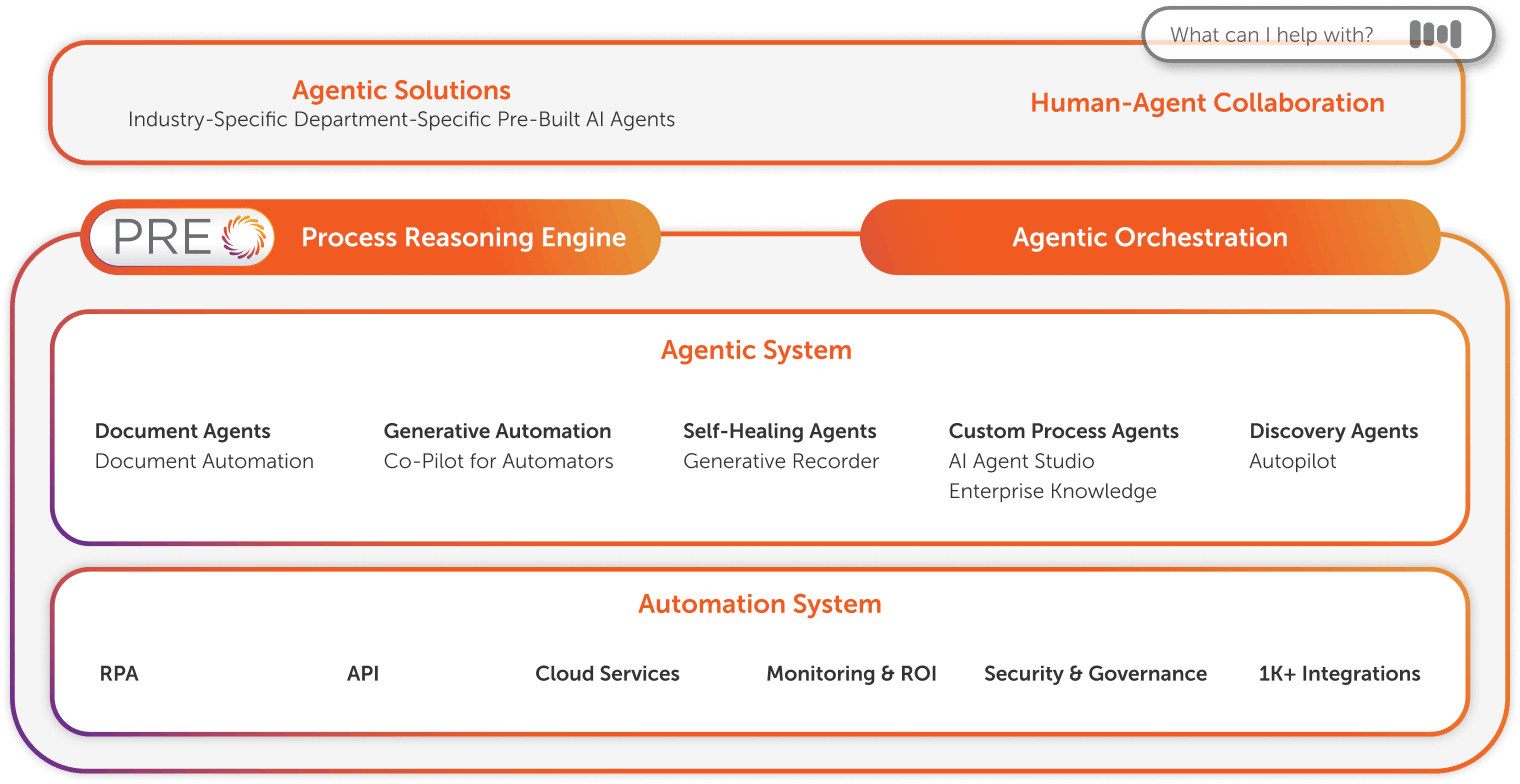Key pillars of modern Agentic Process Automation (APA)
Autonomous intelligence
Goal-driven AI agents plan, execute, and self-heal without manual direction.
Real-time orchestration
Seamlessly coordinate agents, bots, APIs, and documents from one unified, governed place to power complex workflows.
Continuous learning
Agents refine their performance over time, optimizing for efficiency and accuracy.
Enterprise-grade trust
Built with secure guardrails and governance for responsible AI.
Why we lead
- Agentic solutions enable seamless human-agent collaboration across every business function.
- Process Reasoning Engine (PRE) powers intelligent decision-making. It learns, adapts, and coordinates agents fueling scalable, resilient automation.
- Mozart Orchestrator connects AI agents, automations, documents, and APIs in a single unified composer to run fully governed dynamic workflows, with no context switching.
- Agentic execution deploys in your VPC for complete data control, compliance, and seamless enterprise integration at cloud scale.

All-in-one ease. Out-of-the-park outcomes.
Auto-create automations
Design and adapt automations faster with the Automator AI toolkit.
Auto-create automationsHigh-Scale Cloud Extraction Service - Document Processing without Limits
Extract, organize, and inject unlimited data into workflows 5x faster with Document Automation.
Process complex documentsDiscover opportunities
Find bottlenecks and what to automate next with Process Discovery.
Discover opportunitiesOrchestrate end-to-end workflows
Automate any process across apps and systems with Automation Workspace.
Orchestrate workflowsAutomate from any app
Use natural language to trigger multi-step agentic workflows in your existing apps with Automation Co-Pilot.
Automate from any appTake a guided tour and see APA in action
What will you automate?
- IT
- Finance & Accounting
- Customer Service
- Operations
- HR

Saved $1M and 125K hours across governance, compliance, security provisioning, and more.

Cut 15K hours/month and saved over $600K in finance tasks from invoice processing to collections and quoting.

50% increase in customer service efficiency and realized 1300% ROI with agentic automation.

Cut operational time by 500 days per month with high-speed agentic automation.

85% reduction in recruitment hours and 52K employee ideas for applying AI + automation.
Frequently asked questions
What is the Agentic Process Automation System?
The Agentic Process Automation Systems combines automation and artificial intelligence (AI) to create automated systems that can almost think and act like humans, handling tasks that are complex and need brainwork. These self-driving workflows are not just following instructions; they're adapting, learning, and getting smarter as they go.
Think of the Agentic Process Automation System as AI's brainpower with automation's muscle, integrating agentic AI agents, machine learning, process orchestration, RPA, APIs, and natural language interfaces with enterprise-grade governance and security.
Automation Anywhere’s Agentic Process Automation System is recognized as the top choice for AI and automation. It works safely and responsibly with any application, team, environment, and data. With our system, the barriers between people, apps, and processes dissolve, making work faster and easier so you can achieve more right away.
How does an Agentic Process Automation System work?
An Agentic Process Automation System works by combining goal-driven AI agents with automation tools, governance, and enterprise context to orchestrate end-to-end workflows.
At its core is the Process Reasoning Engine (PRE), trained on 400M+ enterprise workflow data, UI interactions, and documents. PRE enables AI agents to understand context, plan tasks, adapt dynamically, and collaborate with humans, completing complex business processes securely and at scale.
Here’s a simple breakdown of how it works:
- The first step is to understand how current processes work. Process discovery tools help find inefficiencies and areas where automation can help, creating a clear plan for implementation.
- After identifying processes, the next step is to create agentic workflows. This means designing how tasks will be done, who will do them, and in what order, using AI, RPA, APIs, and process orchestration to create end-to-end automations. An Agentic Process Automation System enables you to design these automations with help from AI, which can assist developers and even create automated workflows for you. The system works across any business app or software, making it easy to implement without disrupting work. And employees can access and apply agentic automations from within everyday applications.
- At the heart of the system are AI agents. These smart programs can analyze information, make decisions, and take action like a human would. Unlike traditional automation, AI agents can adapt to new situations and learn from their experiences.
- AI agents start by collecting data they need to work effectively. They analyze this data to find patterns and insights, which helps them decide what actions to take.
- After analyzing the data, AI agents choose the best actions based on the information. They can handle tasks like sending emails, updating records, or interacting with customers, often at the same time.
- AI agents build ongoing context memory within APA, improving their reasoning and execution over time while staying within enterprise guardrails.
How does an Agentic Process Automation System help teams be more productive and save time?
An Agentic Process Automation System helps teams be more productive and save time in several important ways; here’s how:
- Automating tasks. Many teams spend a lot of time doing the same tasks over and over again, like data entry, report generation, or responding to common questions. An Agentic Process Automation System can take over these repetitive tasks, so employees save time and can focus on more important work that requires creativity and critical thinking—which boosts productivity.
- Faster decision-making. AI agents analyze data quickly and provide insights in real time. This means that teams can make informed decisions faster than if they were doing all the analysis on their own. For example, in finance, an AI agent can quickly assess financial data and suggest the best course of action, so the team acts more quickly.
- Reducing errors. Manual processes often lead to mistakes, whether from typing errors or miscalculations. Agentic automation helps reduce these errors because AI agents can self-correct errors as well as follow set rules consistently. The result is much less time fixing mistakes and higher-quality work.
- Integration with existing tools. The Agentic Process Automation System works with the tools and software teams are already using, like email, project management apps, or customer relationship management (CRM) systems. This makes it quick for teams to adopt automation for faster, more efficient workflows because they don’t have to learn a whole new system.
- Better collaboration. Agentic automation can automatically assign tasks based on team members’ availability and skills, ensuring that the right person is working on the right task at the right time. This makes teamwork more efficient and helps projects move forward.
- Flexibility and adaptability. Adaptiveness is a top feature of agentic automation, which is responsive to changing business needs and priorities. If a team’s workload increases, the automation can quickly scale up to handle more tasks without needing additional resources. This flexibility means that teams can respond to challenges or opportunities more effectively, keeping them productive.
What teams can use an Agentic Process Automation System?
Almost any team within an organization can benefit from using an agentic process automation system to simplify and speed workflows. Because agentic automation is so smart and adaptive, you can apply it to nearly any business task or process.
For example:
- IT teams: IT departments can use agentic automation to streamline processes like software deployments, system monitoring, and data management.
- Customer service: Customer service teams can use AI agents to handle common inquiries, manage ticketing systems, and provide quick responses to customers.
- Finance and accounting: These teams can apply agentic automation to tasks like invoice processing, expense tracking, and financial reporting.
- Human resources: HR departments can use agentic automation to free up time for strategic initiatives like talent development and employee engagement by automating things like employee onboarding, payroll processing, and managing benefits.
- Sales and marketing: Sales and marketing teams can use agentic automation to work more efficiently and make data-driven decisions. For example, AI agents can manage lead generation, track customer interactions, and analyze marketing campaigns.
- Operations: Operations teams can use agentic automation for supply chain management, inventory control, and production scheduling to improve efficiency and reduce costs.
- Compliance and risk management: These teams can use agentic automation to streamline compliance checks, monitor regulatory changes, and conduct audits. Agentic automation ensures that compliance processes are consistent and reduces the risk of human error.
Should enterprises start adopting agentic process automation now or wait until the technology is more mature?
Starting to use agentic process automation represents a major opportunity to get ahead in a fast-moving market reality that is not going to wait for you to catch up. Adopting agentic automation now gives you the chance to shape your strategy, innovate, and implement the technology in ways that best fit into operations.
Building on existing powerful automation + AI tools, agentic automation is already making waves by helping businesses work more efficiently and make smarter decisions in real time. It’s important to keep in mind that leading platforms come equipped with strong security and governance options. So, while agentic automation is evolving quickly, companies can safely adopt the technology with full privacy and security today.
APA includes AI guardrails for policy enforcement, role-based access, decision logs, and real-time monitoring—ensuring auditable, governed automation for mission-critical workflows.
How does agentic automation work alongside our existing RPA/BPM investments?
Agentic automation is more flexible and adaptable than any other approach to automation. That means it works exceptionally well not just alongside, but with existing systems—easily connecting and executing tasks everywhere across the business.
By building on existing tools and investments, agentic automation allows you to tackle complex workflows that were previously difficult or impossible to manage, let alone automate. In short, it takes automation efforts, whether with RPA, BPM, or any other method, much farther than ever before.
Here's how it works: Agentic automation combines the power of traditional automation tools with advanced AI. It breaks down the barriers between decision-making and getting work done; it can analyze data, interpret context, make decisions, and then take action across any system. This combination of reasoning, decision-making, and action makes it possible for automated workflows to respond to unexpected situations and make informed choices on the fly.
APA extends your RPA and BPM investments by layering AI-driven reasoning and orchestration, enabling automation of cross-system, judgment-based workflows previously out of reach.
Are the AI models used in this system proprietary, or do they leverage third-party AI models (e.g., OpenAI, Google, Anthropic)?
Automation Anywhere’s Agentic Process Automation System uses a combination of proprietary and third-party AI models and retrieval-augmented generation (RAG) with enterprise controls to ensure safe, context-aware use. This means that while Automation Anywhere has developed its own specialized generative AI automation models, it also integrates with third-party AI technologies so you can connect with the AI models that work best for particular use cases from providers like OpenAI, Google, and Anthropic.
By leveraging both in-house and third-party models, the system can deliver a wider range of functionality and solutions while continuously evolving with advancements in AI technology.
For example, Automation Anywhere uses Google Cloud’s large language models and generative AI capabilities to empower users to build automations using natural language. This combination means businesses can harness the strengths of multiple AI technologies, ensuring access to the best tools available for each automation scenario.
How do AI agents handle exceptions, escalations, and human oversight requirements in mission-critical workflows?
APA agents follow defined escalation paths and seamlessly hand off exceptions to humans with full context, combining agentic AI speed with human oversight for regulated or high-value decisions.
When it comes to dealing with exceptions, AI agents can quickly spot when something doesn’t go as planned. For example, if an AI agent runs into unexpected data or a problem in the process, it can automatically follow set steps to fix the issue. This could mean changing the task, trying to solve the problem by itself, or asking a human for help.
For escalations, AI agents can figure out which tasks need to be handled first based on how urgent or complicated they are. If an issue needs human attention, the AI agent can pass it on to the right team member, giving them all the necessary information to solve it quickly. This way, serious problems get addressed right away without bothering staff with every small issue.
Regarding human oversight, the Agentic Process Automation System is built on the premise that clear communication and teamwork between AI agents and human workers is non-negotiable. The platform has features like decision logs and real-time monitoring, which let humans see what the AI is doing at any moment and step in if needed. This means that while AI agents can work on their own, there’s always a way for humans to get involved in high-stakes situations.
What mechanisms exist for auditing AI-driven decisions and actions?
The Agentic Process Automation System has several purpose-built mechanisms in place for auditing AI-driven decisions and actions.
- Decision logs: Detailed decision logs record every action taken by AI agents. These logs include information about what the AI did, why it made certain choices, and the data it used. This makes it easy to review decisions later.
- Real-time monitoring: These tools allow users to watch how AI agents are performing at any moment. If something seems off, users can quickly check the logs to understand what happened.
- Regular audits: Audits can be conducted to review AI performance and compliance with company policies. During these audits, teams can analyze the AI's decisions, check for any errors, and ensure that everything aligns with ethical guidelines.
- Transparency: Automation Anywhere believes in transparency in AI operations. This means that users can easily access information about how AI works and how it makes decisions, which helps build trust and accountability.
Can I adopt agentic process automation if you’re still running legacy infrastructure?
Yes, you can adopt agentic process automation even if you're still using legacy infrastructure. In fact, one of the great features of the Agentic Process Automation System is its ability to work with existing applications, including older ones.
Agentic process automation works with any software and application, whether modern cloud-based solutions or legacy systems. This means you don’t have to replace your current infrastructure to benefit from agentic automation.
Agentic automation uses APIs (application programming interfaces) to connect systems. These APIs make it simple for AI agents to communicate with your legacy systems, allowing them to share data and work together smoothly. This way, you can automate processes that involve both new and old systems without any disruptions.
Another feature of the Agentic Process Automation System is that it includes robotic process automation (RPA) capabilities, which are perfect for interacting with legacy applications that may not have modern interfaces. RPA can mimic human actions, such as clicking buttons and entering data, to automate tasks in these older systems.
Adopting agentic process automation can actually help you gradually modernize your infrastructure; as part of the automation process, you will identify inefficiencies and bottlenecks, making it clearer where to plan for future upgrades.
What technical skills do employees need to work with AI agents?
Employees don’t need advanced technical skills to work with AI agents in the Automation Anywhere Agentic Process Automation System; it is designed to be user-friendly and accessible to everyone.
To create AI agents, AI Agent Studio is a low-code workspace that allows employees to create AI agents without needing to know how to code. This means that even if someone doesn’t have an AI programming background, they can still build and customize AI agents using simple drag-and-drop features. This makes it easy for anyone in the organization to get involved in automation.
To use AI agents, Automation Co-Pilot gives employees access to AI agent-driven automations directly within the everyday work applications they’re already using, like email or project management software. This way, employees can interact with AI agents and benefit from automation without needing to learn new software or complex processes.
Get to know the Agentic Process Automation System

For Students & Developers
Start automating instantly with FREE access to full-featured automation with Cloud Community Edition.



